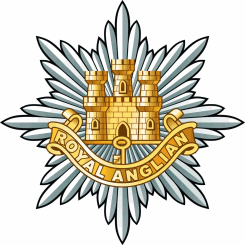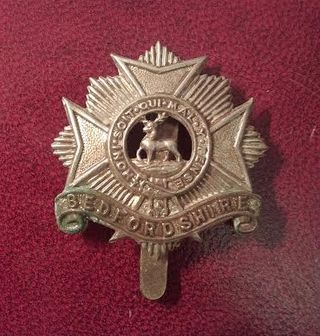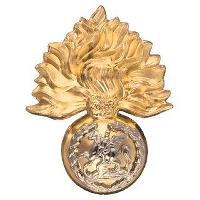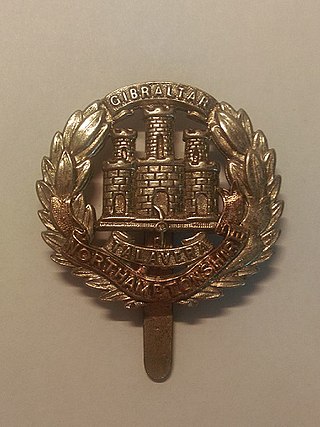
The 54th Infantry Division was an infantry division of the British Army. The division was raised in 1908 following the creation of the Territorial Force (TF) as the East Anglian Division. During the First World War the division fought at Gallipoli and in the Middle East. The division was disbanded after the war but reformed in the Territorial Army in 1920. During the Second World War it was a home service division and did not see any combat service abroad and was disbanded in late 1943 but many of its component units went to see service in the Normandy Campaign and North-western Europe from June 1944 to May 1945.

The Royal Anglian Regiment is an infantry regiment of the British Army. It consists of two Regular battalions and one Reserve battalion. The modern regiment was formed in 1964, making it the oldest of the line regiments now operating in the British Army, and can trace its history back to 1685. The regiment was the first of the large infantry regiments and is one of the three regiments of the Queen's Division.
The 3rd East Anglian Regiment was an infantry regiment of the British Army.
The East of England Regiment (EER) was the infantry unit of the Territorial Army of the East Midlands and East Anglia from 1 July 1999 to 1 April 2006. Upon the re-organisation of the infantry in 2006, the regiment became 3rd Battalion, Royal Anglian Regiment.
The 54th Infantry Brigade was an infantry brigade of the British Army that saw active service in both the First and Second World Wars.
The 1957 White Paper on Defence was a British white paper issued in March 1957 setting forth the perceived future of the British military. It had profound effects on all aspects of the defence industry but probably the most affected was the British aircraft industry. Duncan Sandys, the recently appointed Minister of Defence, produced the paper. The decisions were influenced by two major factors: the finances of the country and the coming of the missile age.

The 49th Infantry Brigade, later known as 49th (Eastern) Infantry Brigade during the Cold War, was a brigade of the British Army.

The Bedfordshire and Hertfordshire Regiment was the final title of a line infantry regiment of the British Army that was originally formed in 1688. After centuries of service in many conflicts and wars, including both the First and Second World Wars, the regiment was amalgamated with the Essex Regiment in 1958 to form the 3rd East Anglian Regiment. However, this was short-lived and again was amalgamated, in 1964, with the 1st East Anglian Regiment and 2nd East Anglian Regiment, and the Royal Leicestershire Regiment to form the present Royal Anglian Regiment.
The Home Counties Brigade was an administrative formation of the British Army from 1948 to 1968. The Brigade administered the regular infantry regiments of the Home Counties of south east England.

The Fusilier Brigade was an administrative brigade of the British Army from 1958 to 1968, that administered those English infantry regiments titled as fusiliers.
The Forester Brigade was an administrative formation of the British Army from 1948 to 1964. The Brigade administered the regular infantry regiments of the English Midlands.
The Yorkshire Brigade was an administrative brigade formation of the British Army from 1948 to 1968. The brigade administered the regular infantry regiments of Yorkshire, England.

The Northamptonshire Regiment was a line infantry regiment of the British Army in existence from 1881 until 1960. In 1960, it was amalgamated with the Royal Lincolnshire Regiment to form the 2nd East Anglian Regiment, which was amalgamated with the 1st East Anglian Regiment, the 3rd East Anglian Regiment and the Royal Leicestershire Regiment to form the present Royal Anglian Regiment.
The 2nd East Anglian Regiment (Duchess of Gloucester's Own Royal Lincolnshire and Northamptonshire) was a short-lived infantry regiment of the British Army from 1960 to 1964. Its lineage is continued by the Royal Anglian Regiment.
The 3rd Battalion, Royal Anglian Regiment "The Steelbacks" is the Army Reserve unit of the Royal Anglian Regiment and is made up of volunteers who train in their spare time as soldiers. It was established on 1 April 2006, it was formed from five of the six companies of the East of England Regiment with A, B, C, E and HQ companies going to 3 Royal Anglian and D Company going to the 4th (V) Battalion, Mercian Regiment. In 2021, under the Future Soldier it was announced that the 19th Brigade would be re-formed with its headquarters in York. The brigade will be tasked with home defence and home 'resilience' duties. The brigade re-formed on 23 July 2022 under command of 1st Division. Their Brigade Flash will no longer be the Desert Rat, it will be replaced with a Black Panther Head.

The Duke of York's Own Loyal Suffolk Hussars was a Yeomanry regiment of the British Army. Originally formed as a volunteer cavalry force in 1793, it fought in the Second Boer war as part of the Imperial Yeomanry. In the World War I the regiment fought at Gallipoli, in Palestine and on the Western Front. The unit was subsequently converted into a Royal Artillery unit, serving in the anti-tank role North Africa, Italy and France during World War II. The lineage is maintained by No. 677 Squadron AAC.

The Hertfordshire Yeomanry was a Yeomanry Cavalry regiment of the British Army that could trace its formation to the late 18th century. First seeing mounted service in the Second Boer War and World War I, it subsequently converted to artillery. Three regiments saw service in World War II, one of which was captured at the fall of Singapore. It continued through various postwar amalgamations and its lineage was maintained by 201 Battery, 100th (Yeomanry) Regiment Royal Artillery until that unit was placed in suspended animation in 2014.

The East Midland Brigade was an infantry brigade of the Territorial Force, part of the British Army, that was raised in 1908. As the name suggests, it commanded infantry battalions recruited in the East Midlands of England: Bedfordshire, Northamptonshire, Cambridgeshire and Hertfordshire. The brigade was an integral part of the East Anglian Division.
220th Brigade was a Home Service formation of the British Army during the First and Second World Wars.
The IV East Anglian Brigade of the Royal Field Artillery was a unit of Britain's Territorial Force (TF) from 1908 to 1919. It served in the Sinai and Palestine Campaign during World War I.








